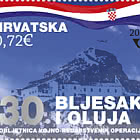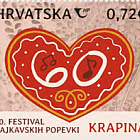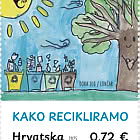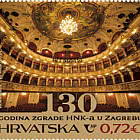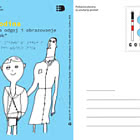Croatian Marian Shrines (C)
Mary is the mildness of the hereafter. She is the faith in the power of love to correct injustice. This is why her shrines on this Earth are called sanctuaries. The network of those sanctuaries is like a reflection of heavenly constellations. Croatia has an ancient network of its own, which has been visited by pilgrims for centuries. Croatian Post has decided to share the images of the most important of those shrines with the world by creating a series of stamps dedicated to this part of our spiritual and artistic heritage, as well as some of our greatest achievements in painting. The paintings and statues of Mary which are worshipped in those shrines have shared the trying history of its people, so they also stand witness to their difficult and persistent survival on the Croatian soil.
The Croatian national shrine of the Mother of God of Bistrica in Marija Bistrica
Our most famous Marian shrine is the basilica minorin Marija Bistrica. The town of Bistrica was recorded for the first time in 1209, while the first record of a parish with a church occurred in 1334. The building was certainly erected before this first record. Its medieval design was gradually given Baroque features, and in the late 19th century, the architect Hermann Bollé redesigned it as a romantic historicist complex, a picturesque sacral burg of sorts. The complex was also enhanced by the architect Stjepan Planić. The church surroundings have been affected through the installation of outdoor prayer spaces for thousands of pilgrims. Many artists have left their works of art in this shrine, from Ferdo Quiquerez, whose works can be found in the redesigned arched porch, to Krsto Hegedušić, Željko Hegedušić, Zlatko Šulentić and others, who were saved by the beatified Alojzije Stepinac in the Second World War. The Stations of the Cross next to the church were designed by our prominent modern sculptors (Kruno Bošnjak, Ante Orlić and Marija Ujević, Stanko Jančić, Josip Poljan and Ante Starčević), based on the idea put forward by Archbishop Antun Bauer and his bishop coadjutor Stepinac. In 1998, Pope Saint John Paul II visited Marija Bistrica, where he beatified Alojzije Stepinac.
The statue of the Mother of God of Bistrica is a 15th-century Gothic wooden statue, known as the Black Madonna with Child. The cult of the black Madonna is present throughout Europe; these statues can be found in some of the most famous shrines, such as Loreto, Einsiedeln or Częstochowa. Some were originally black, and some have turned black over time, but they are worshipped as black. The symbology of those statues dates back to pre-Christian times, and they were accepted in accordance with the recommendation of Pope Gregory the Great concerning inculturation. To protect it from the Turkish invasion, the statue from Bistrica was hidden twice, in the 16thand 17thcenturies, and it was not easy to find since it was buried under the church choir or built into a window; many fantastic legends attest to this. All the way through to today, this statue has been credited with granting many blessings, which makes it the favourite object of worship for the Croatian people.
Church of the Visitation of the Blessed Virgin Mary in Voćin
The shrine of Our Lady of Voćin is a church that makes everyone’s heart skip a beat, if they have one. It epitomizes the events of Stanko Andrić’s “History of Slavonia in Seven Fires”, but also the history of Croatia in seventy-seven fires. The complexity and theatricality of its history are beyond compare. It therefore calls for a lengthier description.
The first record of the parish of Voćin dates back to 1334, but the church is certainly even older than that. In the then important town of Voćin, an estate owned by the most powerful of Croatian noble families, with a Templar fort, ten to twenty clergymen, two monasteries and a significant number of young scholars dispersed throughout the world, John Corvinus or, according to a different theory, the dukes from the House of Ilok, erected this church. Its stellar vault above the shrine and the nave makes it a unique example of the influence of the Czech Gothic in this part of Central Europe. It is the size of a cathedral: it is almost thirty-five metres long and, at one point, its tower was forty metres tall. Amidst the civil war between John Zápolya and Ferdinand I, Holy Roman Emperor, followed by the Ottoman conquest, the population underwent some profound changes. The church was not transformed into a mosque, but it was left to decay.
Christianity was preserved by the Franciscans from the Province of Bosna Srebrena. After the expulsion of the Turks and the Treaty of Karlowitz in 1699, interest shown by the bishops of Zagreb encouraged the reconstruction of the church to begin in 1743. In 1748, the statue of the Mother of God, which came to be considered miraculous, was acquired in Osijek. In 1749, the church suffered severe lightning damage, but the statue was left unscathed. In 1756, “the church had everything it needed”. However, it was soon damaged by severe humidity. It was maintained by the Counts Janković and, in the period of the historicist restoration, the noble Jewish family Gutman, who even succeeded in introducing the railway to Voćin, also helped the church. In 1885, a statue of Our Lady of Lourdes, a new form adopted by the Marian cult, was installed in the church and it soon came to be worshipped as miraculous.
The old statue, which suffered destruction in the meantime, is probably preserved in the 1770 painting, which is now the focus of worship in Voćin. During the Second World War, the painting was preserved by the pastor Martinac, who was killed by the Partisan movement in 1943. In 1944, without any opposition from the Croatian fascist movement Ustasha, the German army burnt down Voćin, considering it a potential Partisan stronghold. The church was demolished, pillaged and set on fire, suffering damage much worse than that inflicted by the Turks. An Eastern Orthodox church was also demolished. The reconstruction did not begin until 1971. In 1984, the church was consecrated to great elation. No more than seven years after it was reconstructed, on 13 December 1991, rebel Serbs and the Yugoslav army destroyed the church using explosives and grenades.
The image of this ruin, pointing its finger to the sky, has been forever engraved in our memories. Due to the vital importance of the church in Voćin, it was decided that it should be reconstructed in its original form, in accordance with the plans provided by the architects Sena Sekulić Gvozdanović, Vladimir Bedenko and Boris Vučić Šneperger, who led the construction. The cornerstone was blessed by Saint John Paul II in 1998 and the church was consecrated in 2011. This reconstruction earned the First Bishop of Požega, Antun Škvorčević, the privilege of being one of the prominent bishops who shaped the history of this emblematic church. Bishop Škvorčević compensated for the loss of the historical collection by introducing select new works of art, authored by Ljubić, Poljan, Mikulin, as well as some drawings by Dulčić and Ivančić, and, above all, the brilliant Šime Vulas ensemble at the centre of the church.
In a time when oblivion seems to come easily and our own (universal) values are degraded, the painting of Our Lady of Voćin, “The Mother of Refuge”, a light saved from the expanse of darkness, reminds us that in the words of Ivan Mažuranić’s Death of Smail-Aga Čengić: “nor should you be proclaimed barbarians / just for dying while they slept.” Our Lady of Voćin, the Mother of Refuge, could rightfully bear another name: the Mother of Perseverance.
Željka Čorak,
Member of the Croatian Academy of Sciences and Arts
Croatia - Recommended stamp issues
WOPA+ recommended stamp issues
| Avatar - Fire and Ash |
| Issued: 03.12.2025 |
| ›New Zealand |
| 50th Anniversary of the Founding of the 24th November Bar Scout |
| Issued: 24.11.2025 |
| ›Montenegro |
| Krisjanis Valdemars |
| Issued: 02.12.2025 |
| ›Latvia |
| Sign Language - Good |
| Issued: 02.12.2025 |
| ›Bosnia and Herzegovina - Republic of Srpska |
| In Memory of the Fallen and Murdered on October 7, 2023 |
| Issued: 08.10.2025 |
| ›Israel |
| Annual Collection Folder (New York) |
| Issued: 05.12.2025 |
| ›United Nations |
| Year Set |
| Issued: 24.11.2025 |
| ›Isle of Man |
| Shipping in the 17th and 18th Centuries - Peat Shipping |
| Issued: 05.12.2025 |
| ›Netherlands |










